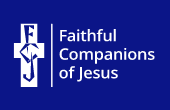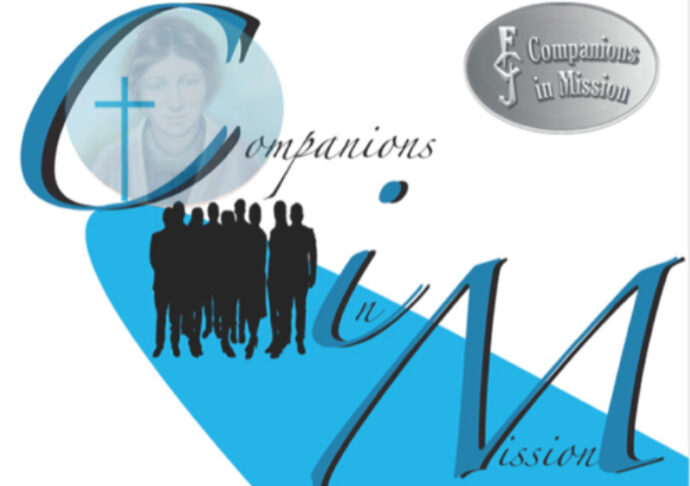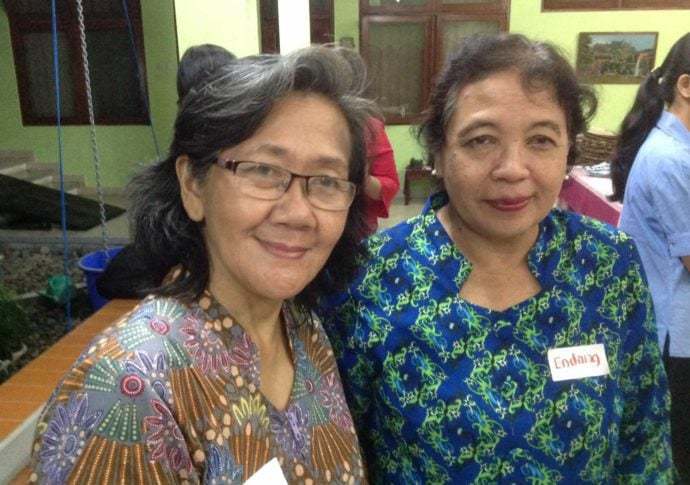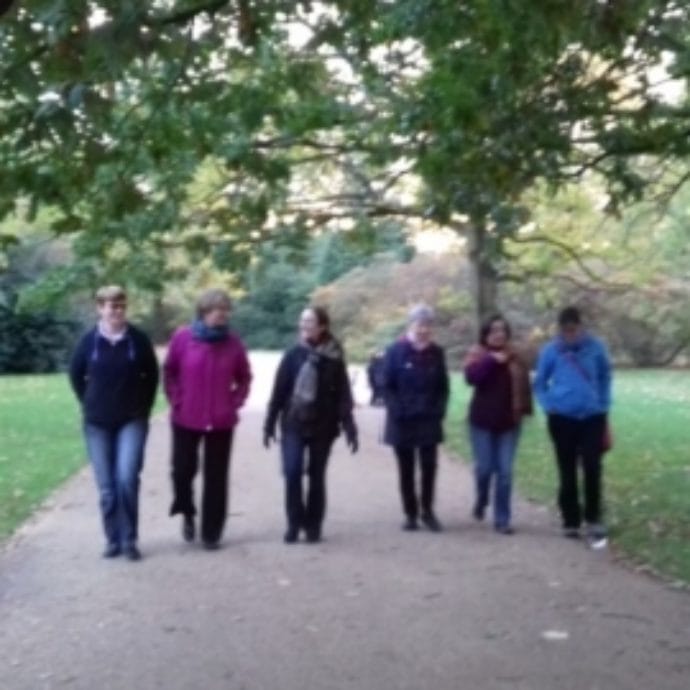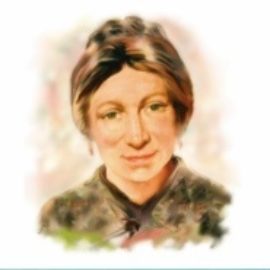A contemporary art installation by Chilean poet and artist Cecilia Vicuña inspires Sr Teresa White fcJ to reflect on our common home and Pope Francis’ encyclical Laudato Si’. A shortened version of this article has first appeared in Church Times and is reproduced here with permission.
Gaze, consider, contemplate – St Clare of Assisi
Gaze
“Generations have trod, have trod, have trod;
And all is seared with trade; bleared, smeared with toil;
And wears man’s smudge and shares man’s smell: the soil
Is bare now…”
G. M. Hopkins, God’s Grandeur
Recently, on a chance visit to Tate Modern, I quite literally walked into an amazing work of art: Brain Forest Quipu – Poems in Space. Billed as an installation in sculpture and sound, it was created by the Chilean poet and artist, Cecilia Vicuña.
As I walked through a forest of fragile ‘trees’ – long strips of white muslin-like fabric suspended from the high roof, and trembling in the air currents wafting through the vast Turbine Hall – I became aware that I had entered a curiously lifeless, colourless region, unsettling and eerie. There was no living green in this forest, and the wordless ‘poems in space’ hanging there were little more than ashen shapes and shadows: knotted strings, ropes and cords, whitish woven fabrics, scraps of wool, bleached tree bark, cardboard silhouettes, plant fibres, animal bones and skins. In the background, indigenous South American music was being played, and snippets from modern compositions too, interspersed with long, silent pauses. From time to time, sounds from the natural world could be heard: gusting wind, the ‘plop’ of heavy raindrops, water flowing, the mournful howl of wolves, distant bird calls. This sonic element did nothing to mitigate the sense of menace that hung over the entire scene. I felt as if I had been transported into another universe, desolate, ghostly, dying. It was only later that I learned what ‘quipu’ were, but I had already experienced their power.
Five thousand years ago, the Incas, who ruled the scattered cultures of the longest mountain range in the world, the Andes, did not communicate through written words – writing, as we understand it, was unknown to them. Instead, they devised a symbolic language, creating abstract sculptures to share news, record memories, and to count. To do this, they used knots (‘quipu’) and a system of sightlines (‘ceque’), making them clearly visible by suspending them from trees, plants, and overhanging rocks. Hence the quipu served as a tactile, three-dimensional metaphor for the union of numerous Andean tribes and clans. Quipu were banned after the European Conquest of South America, and thousands of them were burned. The local people were forced to abandon their ancient system of communication, considered by the invaders to be primitive, pre-literate, and, in its place, they were introduced to European writing and numerals. Gradually, they learned to speak and write in the languages of their conquerors, Spanish or Portuguese, which they do to this day.

By Cecilia Vicuña. (Image by diamond geezer)
But it seems that the symbolic dimension of the quipu, that unique inheritance of the Andean peoples, did not die, and the vision of passing on news and information through creative artefacts rather than words endures to this day. Cecilia Vicuña is a living proof of this, as she re-interprets the quipu and in doing so, communicates a powerful message for our time. Through her strangely beautiful and poignant artwork, which will be on display until April 2023, she has a wordless message: tread gently on the earth, respect it and care for it – otherwise the fragile bio-diverse environment of our planet will be lost to future generations of humans, animals, and other living things. Her installation spells out the consequences of disproportionate, disrespectful anthropocentrism, showing how the exploitation of the natural world by humans, especially over the last two centuries, has led to the critical warming of our climatic system. In ‘Brain Forest Quipu’, by reviving an ancient Andean custom, Cecilia quietly intones a lament for a dying planet. Her poems in space focus the eye, the mind, and the heart: we have mistreated our common home, and as a result, the global ecosystem is at risk. In a muted, undramatic way, she is telling us that the planet may survive, but we will not… We must radically change our behaviour, or we perish.
Consider
“O if we but knew what we do
When we delve or hew –
Hack and rack the growing green!”
G. M. Hopkins, Binsey Poplars
The artistic vision of ‘Brain Forest Quipu’ wordlessly invites its audience to participate in a wider conversation on the climate emergency, and to take time to consider the evident fragility of the planet that is our home. Human exploitation of the natural world, especially over recent centuries, has led to the pollution of air, soil and water, which has increased exponentially; in addition, forests have been plundered and destroyed, and thousands of plant and animal species have become extinct. Global warming, caused by excessive and irresponsible human interference in the ecosystem, is accelerating; the signs are before our eyes: erratic weather patterns, ongoing desertification, tornadoes, droughts, floods, wildfires, melting ice-caps and glaciers, soaring temperatures, rising sea levels, etc. Many people would say that climate change as we are already experiencing it is nature’s signal to us to change radically the way we live. If the world as we know it is not to be devastated through human activity, we need to give serious consideration to some crucial questions concerning our future. What are we doing, and what more could we do – individuals, groups, families, villages, towns, cities, nations, governments, faith groups – to lessen the detrimental impact of our actions and lifestyle on the earth in its present state of extreme fragility? How could we save the planet?
That wider conversation on ecological degradation had, of course, been initiated long ago by scientists (especially ecologists), philosophers, poets, and theologians. 2015, however, marked an important step on the path towards a more open and universal recognition of the fragility of the environment. In that year, another South American, Pope Francis, through his Encyclical Letter, Laudato si’, brought the climate emergency unambiguously into the domain of religion. Religious faith acknowledges the mystery at the heart of existence, and holds that we can relate to that mystery in and through the physical universe, which science investigates and explores. Believing that science and religion are natural companions, Francis holds that together the two disciplines have the capacity to consider creation in a way that integrates physical, biological, spiritual, and ethical perspectives. While Cecilia fashions ‘poems in space’ to transmit her message, Francis uses the written word to draw attention to the plight of the natural world, which he believes to be God’s beloved handiwork:
Creation has to do with God’s loving plan, in which every creature has its own value and significance… [it] can only be understood as a gift from the outstretched hand of God.
Laudato si’ 76.

Cecilia Vicuňa invites us to gaze at the world around us, to look and see what is happening there. She offers no words of warning, proposes no aims and objectives leading to specific actions: she allows her artwork to speak for itself. Francis does not rule out the gazing – he presumes it, pointing out that the earth “is beginning to look more and more like an immense pile of filth” (LS §21); but he goes on to call us to consider the harm that generations of humans have inflicted, and continue to inflict, on our planet, with the resulting climatic changes we are experiencing today. He urges us to ponder not only the symptoms of these changes, but also the causes.
In recent years, through our technologies, we have taken extensive control of the life-systems of the earth, effectively deciding what species will live or become extinct, and interfering with the chemical composition of soil, air, and water. Since climate change has now reached a tipping point, dialogue, leading to urgent action, communal action, on the part of governments, nations, and individuals, is essential. By choosing to collaborate, individually, nationally, and globally, there is still time to reverse or at least alleviate some of the most worrying trends. In the light of such considerations, Francis encourages us to foster and deepen within ourselves a contemplative consciousness that opens our eyes to the interconnectedness of all created things, and helps us to seek a serene harmony with the natural world, our God-given home.
Contemplate
“There lives the dearest freshness deep down things…”
G. M Hopkins, God’s Grandeur
Cecilia Vicuña’s artwork draws us into a space of attentiveness to what we see and hear around us. Her creative sculptures inspire us, motivate us, to take time for contemplation in our busy lives, so that we can look at life in fresh new ways. Pope Francis advocates this contemplative approach, believing it has the capacity to free us from our obsession with endless activity, production, and consumption. He says that the intensified pace of life and work that so many of us experience today can drive us to frenetic activity. He calls this phenomenon “rapidification”, pointing out that living in a state of constant hurry, noise, and distraction “contrasts with the naturally slow pace of biological evolution” (LS §18). Our busy, workaholic mentality can lead us to ride rough-shod over everything around us: it affects the way we treat the earth, forgetting that our planet is “a collective good, the patrimony of all humanity and the responsibility of everyone” (LS §95). This state of affairs has caused many of us to become such aggressive activists, such compulsive consumers, that our unsustainable lifestyle and its throwaway culture has contributed to the catastrophic impoverishment of the natural environment that is so evident in our world today. We seem to have lost sight of the fact that the natural world does not exist simply to provide human needs; before God, it has its own intrinsic value.
According to Francis, contemplation, lived out authentically, leads to “a balanced lifestyle, together with a capacity for wonder which takes us to a deeper understanding of life” (LS §225).
In quiet moments, we may come to realise that an intentional simplification of our lifestyle, a heightened concern for the common good, and a more conscious respect for God’s creation could not only release us from many of our present anxieties, but could also improve the quality of our lives. He sees contemplation as an attitude of the heart that protects human activity from becoming merely empty activism. It involves slowing down, and taking on an attitude of deep listening. This enables us to be fully present, in heart, mind and body, to what is, and also to respond creatively as we look towards what could be. If, in our busy, noise-filled lives, we make space for moments of contemplation, we will find ourselves able to bring before God some of the unspoken pleas, dreams and longings struggling for expression in our troubled, divided, and wounded world. In the stillness, our innate capacity to hear God’s word will be sharpened. When we take that word into our minds and hearts, we will find ourselves looking upon creation with loving eyes. Perhaps then we will see that our common human task at this time is “to undo as much as we can of the damage already done, and to contribute creatively to saving the planet and enriching its future”[1]. Under God, the fruitful existence of future generations of living things is in our hands.
[1] Denis Edwards, ‘Jesus and the Cosmos’, St Paul Publications 1991, p. 140
Sister Teresa White fcJ’s book, Hope and the Nearness of God: The Lent Book 2022, was published by Bloomsbury. Read more of Sr Teresa’s contributions to our website.
Photo credits: Artist and poet Cecilia Vicuña at Museno Nacional de Bellas Artes, Chile (Wikimedia). Images of Brain Forest Quipu by Cecilia Vicuña by diamond geezer/flicker and Maureen Barlin/flickr
